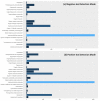Human Milk from Tandem Feeding Dyads Does Not Differ in Metabolite and Metataxonomic Features When Compared to Single Nursling Dyads under Six Months of Age
- PMID: 36355152
- PMCID: PMC9696481
- DOI: 10.3390/metabo12111069
Human Milk from Tandem Feeding Dyads Does Not Differ in Metabolite and Metataxonomic Features When Compared to Single Nursling Dyads under Six Months of Age
Abstract
Given the long-term advantages of exclusive breastfeeding to infants and their mothers, there is both an individual and public health benefit to its promotion and support. Data on the composition of human milk over the course of a full period of lactation for a single nursling is sparse, but data on human milk composition during tandem feeding (feeding children of different ages from different pregnancies) is almost entirely absent. This leaves an important knowledge gap that potentially endangers the ability of parents to make a fully informed choice on infant feeding. We compared the metataxonomic and metabolite fingerprints of human milk samples from 15 tandem feeding dyads to that collected from ten exclusively breastfeeding single nursling dyads where the nursling is under six months of age. Uniquely, our cohort also included three tandem feeding nursling dyads where each child showed a preferential side for feeding-allowing a direct comparison between human milk compositions for different aged nurslings. Across our analysis of volume, total fat, estimation of total microbial load, metabolite fingerprinting, and metataxonomics, we showed no statistically significant differences between tandem feeding and single nursling dyads. This included comparisons of preferential side nurslings of different ages. Together, our findings support the practice of tandem feeding of nurslings, even when feeding an infant under six months.
Keywords: breastfeeding; human milk; infant feeding; lactation; metabolome; microbiome; tandem feeding.
Conflict of interest statement
NS is supported by a UKRI Future Leaders Fellowship and is a non-remunerated Trustee of the Human Milk Foundation. The Parenting Science Gang was supported by Wellcome Trust public engagement fund grant 204786/Z/16/Z. No funder or supporter was involved in decisions on study design, execution, data analysis, reporting, manuscript writing, or publication. We also acknowledge support from Imperial College NIHR Biomedical Research Centre that funds the research infrastructure that supported this work. This article is independent research supported through infrastructure funded by the NIHR BRC, and the views expressed in this publication are those of the authors and not necessarily those of the NHS, NIHR, or the Department of Health and Social Care.
Figures





Similar articles
-
Metabolomic and Metataxonomic Fingerprinting of Human Milk Suggests Compositional Stability over a Natural Term of Breastfeeding to 24 Months.Nutrients. 2020 Nov 11;12(11):3450. doi: 10.3390/nu12113450. Nutrients. 2020. PMID: 33187120 Free PMC article.
-
Tandem Breastfeeding: A Descriptive Analysis of the Nutritional Value of Milk When Feeding a Younger and Older Child.Nutrients. 2021 Jan 19;13(1):277. doi: 10.3390/nu13010277. Nutrients. 2021. PMID: 33478010 Free PMC article.
-
Fecal Bacterial Communities Differ by Lactation Status in Postpartum Women and Their Infants.J Hum Lact. 2022 May;38(2):270-280. doi: 10.1177/08903344211060343. Epub 2021 Dec 13. J Hum Lact. 2022. PMID: 34903081
-
Oral galactagogues (natural therapies or drugs) for increasing breast milk production in mothers of non-hospitalised term infants.Cochrane Database Syst Rev. 2020 May 18;5(5):CD011505. doi: 10.1002/14651858.CD011505.pub2. Cochrane Database Syst Rev. 2020. PMID: 32421208 Free PMC article.
-
Human milk and breast feeding: an update on the state of the art.Pediatr Res. 1982 Apr;16(4 Pt 1):266-71. doi: 10.1203/00006450-198204000-00003. Pediatr Res. 1982. PMID: 7043382 Review.
References
-
- Bryant T. Tandem Nursing: A Review and Guidelines. Int. J. Childbirth Educ. 2012;27:84–88.
-
- Renfrew M., McAndrew F., Thompson J., Fellows L., Large A., Speed M. Infant Feeding Survey 2010. Health and Social Care Information Centre; Leeds, UK: 2012. p. 2.
Grants and funding
LinkOut - more resources
Full Text Sources
Miscellaneous

